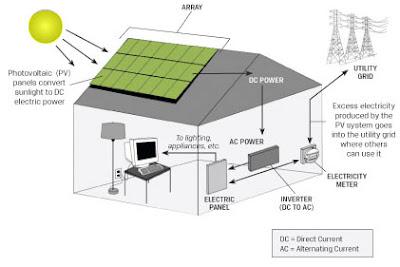Solar Panel: As earlier reviewed Solar Panels are made of silicon and constitute a group of interconnected Photovoltaic (PV) cells that directly convert light into Direct-Current (DC) electricity or energy at the atomic level, depending on the light incidence and without an external voltage source.
Inverter: Appliances in a home run on AC or Alternating Current, but the solar panels produce DC current so there must be a conversion from DC into AC before using this energy produced. The inverter simply converts one type of voltage into another - in this case DC to AC.
Charge controller and battery: With no sunlight at night but with a higher energy demand for non grid tied installations, extra energy produced during the day must be stored in specially designed 'Deep Cycle Batteries' for later use. The controller regulates the amount of energy flowing into a battery at a specific time.Electric Meter: These are specially designed meters used in PV installations that help feed excess electricity into the grid.
 As the image illustrates, Solar PV modules produce and supply DC electricity. The inverter converts this electricity into AC current that is household appliance 'friendly'. A typical home will consume electricity supplied by the panels while compensating with electricity from the grid. The two way electricity meter will continually measure the home's electricity production and consumption. It also helps to back-feed excess electricity produced into the grid for grid tied installations.
As the image illustrates, Solar PV modules produce and supply DC electricity. The inverter converts this electricity into AC current that is household appliance 'friendly'. A typical home will consume electricity supplied by the panels while compensating with electricity from the grid. The two way electricity meter will continually measure the home's electricity production and consumption. It also helps to back-feed excess electricity produced into the grid for grid tied installations.
